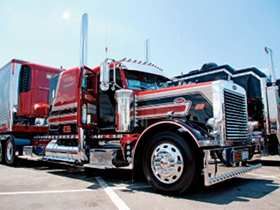Congress Working On New Transportation Bill That Eliminates Extra Hazmat Background Check For TWIC Holders
Topic 19143 | Page 1

What they really need to do is clean up the TSA and CPB processes. A prime example is someone who crosses the border frequently. You can get a GOES Clearance, which is more indepth than any of the TSA Clearances. The TSA will accept a GOES ID as a valid ID to board aircraft, and enter areas without using your drivers license, yet they will not use it to clear for you for HME, PreCheck, or TWIC. The bill should go farther and include GOES Clearance.
TWIC:
Transportation Worker Identification Credential
Truck drivers who regularly pick up from or deliver to the shipping ports will often be required to carry a TWIC card.
Your TWIC is a tamper-resistant biometric card which acts as both your identification in secure areas, as well as an indicator of you having passed the necessary security clearance. TWIC cards are valid for five years. The issuance of TWIC cards is overseen by the Transportation Security Administration and the Department of Homeland Security.
New Reply:
New! Check out our help videos for a better understanding of our forum features

















Preview:








 TT On Facebook
TT On Facebook
In response to concerns raised by government watchdog agencies, that the TSA is not "adequately positioned to identify security risks across different modes of transportation or effectively support federal, state, local and private providers of transportation security.”, a bipartisan group of 4 U.S. Senators has reintroduced the Surface Transportation and Maritime Security Act (S. 763).
Among it's various provisions, is a directive that any individual who has already passed a background check to get, and holds a valid TWIC card does not have to submit to a second, redundant, background check for their Hazmat endorsement. Generally, it eliminates the extra Security Threat Assessment and it's (reduced) fees for drivers who have their TWIC card and need the HME:
Currently: "Reduced rate applicant must already possess a valid TWIC card and be licensed in a state that accepts the TWIC threat assessment in place of the one for the HAZMAT endorsement."
The Hazardous Materials Endorsement Threat Assessment Program
A lot of things happen between the time a bill is introduced and actually getting it through Congress in anything resembling it's original form, so certainly nothing is officially decided. The bill was introduced in the last session of Congress, but too late for it to advance very far.
A number of states were previously determined to have comparable Hazmat background checks, and were already allowed to combine them, but this will establish the practice as the nationwide standard.
The "Surface and Maritime Transportation Security Act"
The added pertinent section reads:
"SEC. 18. BACKGROUND RECORDS CHECKS FOR ISSUANCE OF HAZMAT LICENSES."
"(3) TRANSPORTATION SECURITY CARDS.-An individual who holds a valid transportation security card issued by the Secretary of the departing in which the Coast Guard is operating under section 70105 of title 46 shall be deemed to have met the background records check required under this sub-section.
Other Highlights Of The Bill:
Risk-/based Security Planning: "Requires the TSA administrator to conduct a risk analysis and implement a risk-based security model for surface transportation facilities." and "Mandates risk-based budgeting for surface transportation security focusing resources on current threats with annual reviews of program effectiveness."
Canine Explosive Detection Teams for Surface Transportation: "Authorizes as many as 70 additional canine teams to work in surface transportation security as soon as possible." and "TSA may then raise the total number of canine teams to 200 or higher as identified in TSA’s risk-based analysis."
Enhances Passenger Rail Security: "Authorizes the use of computerized vetting systems for passenger rail at the request of Amtrak police and the Amtrak Board of Directors."
Thune Reintroduces Surface Transportation and Maritime Security Act
The proposed bill aims to assess and streamline surface transportation security, reduce redundancies in the driver credentialing process, and overall make moving hazardous material and accessing security-sensitive areas more efficient, as much as a government agency can be efficient.
External Links:
Trucking Applauds Proposed TWIC Driver-Credential Reform Measure
ATA Applauds Progression in TWIC Program
HAZMAT:
Hazardous Materials
Explosive, flammable, poisonous or otherwise potentially dangerous cargo. Large amounts of especially hazardous cargo are required to be placarded under HAZMAT regulations
BMI:
Body mass index (BMI)
BMI is a formula that uses weight and height to estimate body fat. For most people, BMI provides a reasonable estimate of body fat. The BMI's biggest weakness is that it doesn't consider individual factors such as bone or muscle mass. BMI may:
It's quite common, especially for men, to fall into the "overweight" category if you happen to be stronger than average. If you're pretty strong but in good shape then pay no attention.
Dm:
Dispatcher, Fleet Manager, Driver Manager
The primary person a driver communicates with at his/her company. A dispatcher can play many roles, depending on the company's structure. Dispatchers may assign freight, file requests for home time, relay messages between the driver and management, inform customer service of any delays, change appointment times, and report information to the load planners.Fm:
Dispatcher, Fleet Manager, Driver Manager
The primary person a driver communicates with at his/her company. A dispatcher can play many roles, depending on the company's structure. Dispatchers may assign freight, file requests for home time, relay messages between the driver and management, inform customer service of any delays, change appointment times, and report information to the load planners.TWIC:
Transportation Worker Identification Credential
Truck drivers who regularly pick up from or deliver to the shipping ports will often be required to carry a TWIC card.
Your TWIC is a tamper-resistant biometric card which acts as both your identification in secure areas, as well as an indicator of you having passed the necessary security clearance. TWIC cards are valid for five years. The issuance of TWIC cards is overseen by the Transportation Security Administration and the Department of Homeland Security.